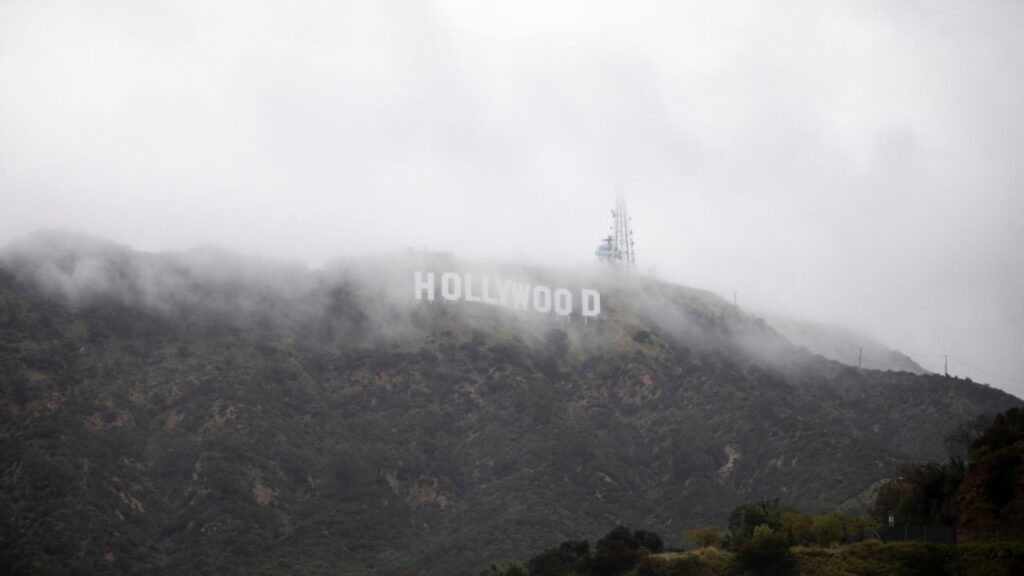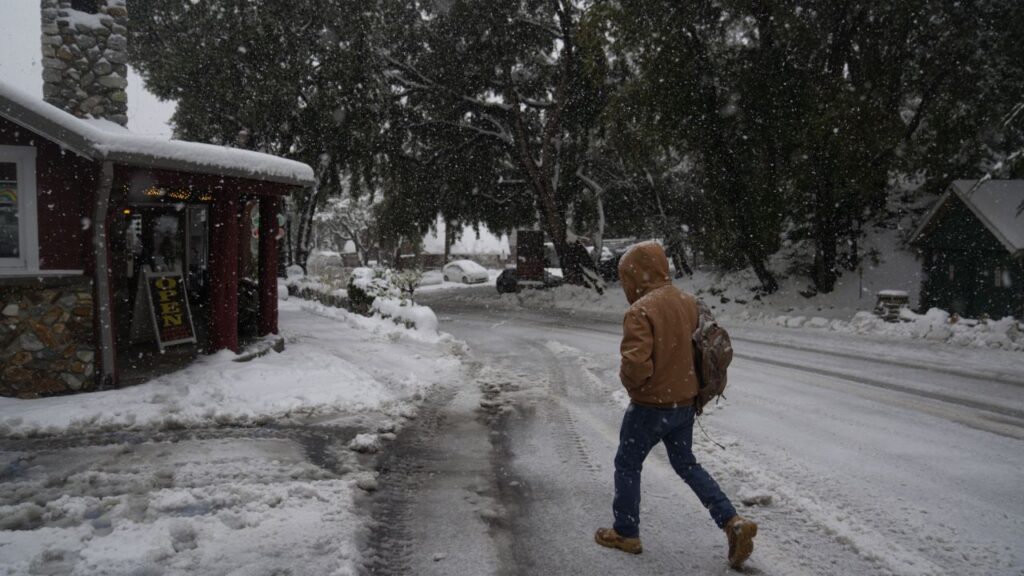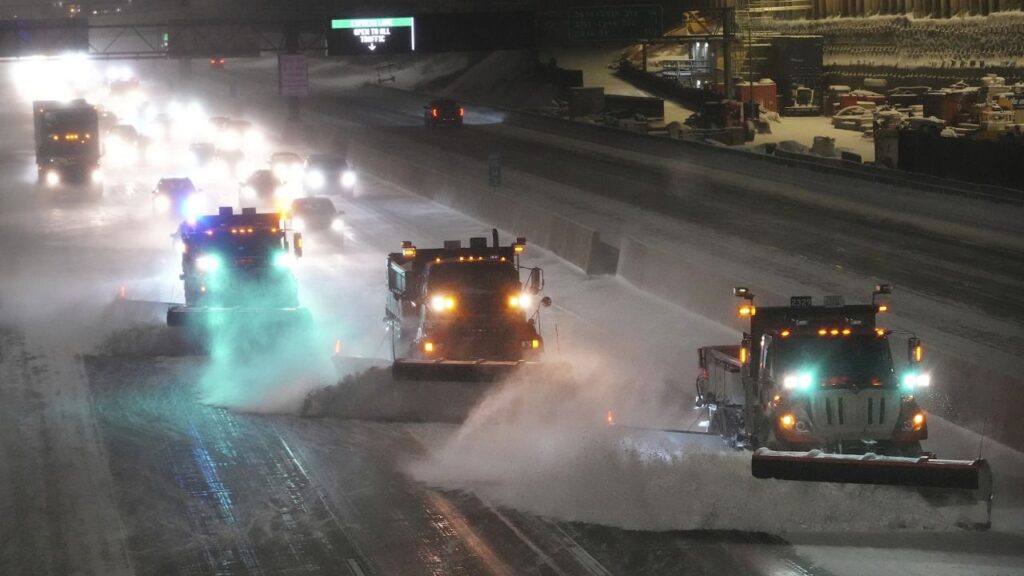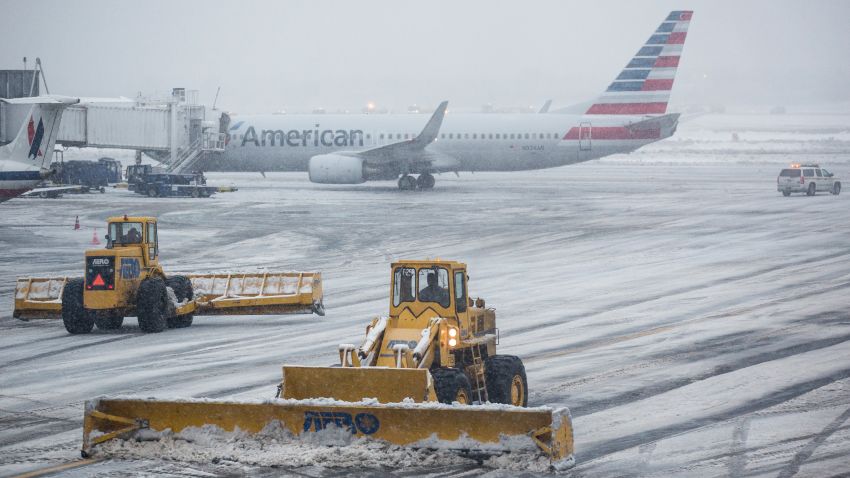Parts of metro Los Angeles are still under a historic blizzard warning as heavy snow and rain pummel region
A rare blizzard warning remains in effect for parts of Southern California – including the Los Angeles region – Saturday as some areas endure heavy snow and record rainfall that has delivered dangerous flooding.
An onset of severe weather across the West Coast has spawned unfamiliar wintry conditions at higher elevations, particularly over mountainous areas of Los Angeles and Ventura counties, where up to a foot of snow may pair with 80 mph winds, the National Weather Service said.
Blizzard warnings are set to continue through Saturday afternoon. The National Weather Service’s Los Angeles office had not issued a blizzard warning since 1989.
At the same time, torrential rain is expected to continue lashing the Los Angeles metro area Saturday after the area experienced flooding a day prior.
“A cold, strong, and potentially dangerous winter storm will bring periods of heavy rain and mountain snow with gusty southerly winds to most of Southwest California through Saturday,” according to the weather service.

The threat of lightning strikes has prompted officials to close all beaches in Los Angeles County to the public, according to an announcement on Saturday by the Lifeguard Division of the Los Angeles County Fire Department. A storm system moving through the area has caused road flooding, including temporary closures of portions of Interstate 5 in Southern California.
The warning comes as this week’s severe weather across the state triggered numerous power outages, which persisted for more than 100,000 homes and businesses in several counties early Saturday as temperatures are expected to plummet, with Northern California possibly seeing below-freezing temperatures.
By Friday, snow had already coated the Santa Cruz Mountains, a sight that was a surprise to resident Ngugi Kihara.
“(We’ve) never seen this much snow up here,” Kihara told CNN on Friday. “We woke up to it. It started yesterday but picked up a lot overnight. Lots of trees are falling and all the roads around us are closed. Power is out and has been mostly gone since Tuesday.”
And the threat of even more power outages persists Saturday, the National Weather Service said.
The heavy snow and strong winds can ultimately result in near zero visibility for those in the area, even when snow stops falling because high winds can blow the flakes off the ground. Weather alerts have urged extreme caution when traveling.
High elevations at Big Bear Lake in Southern California saw between 20 to 40 inches of snow over the course of three days as of Friday evening, according to the National Oceanic and Atmospheric Administration. The agency also reported that many vehicles were stuck Friday morning, prompting state officials to close roads.
In addition to the snow, some Los Angeles-area roads turned into rivers on Friday after bouts of heavy rain, prompting the weather service to issue a flash flood warning.
Motorists and vehicles were seen stranded after water levels rose and some roads became impassable.
During the late night hours, a flash flood warning remained for around 1 million people in Los Angeles, Glendale and Santa Clarita through Saturday morning.

California to see more rain this weekend
Heavy rainfall is expected to continue through the weekend over areas at lower elevations as overnight flash flooding was ongoing north and west of Los Angeles, the Weather Prediction Center said early Saturday.
The region can expect widespread rainfall of 2 to 4 inches Saturday, likely leading to flooding problems in areas south and east of Los Angeles, the prediction center added.
San Diego is also forecast to receive up to 2.5 inches of precipitation, and portions of southwestern California remain in a flood watch through Saturday evening.
Saturday’s rain will hit already soaked grounds, exacerbating impacts of possible flooding as the region faces back-to-back storms this week. In late December into January, much the state was thrashed with rounds of deadly flooding.
On Friday, the rainfall broke several California daily records as of around 5:30 p.m. local time:
- Los Angeles International Airport saw a record rainfall of 1.23 inches. This breaks the previous record of 0.75 inch set in 2008.
- Lancaster was hit with 0.26 inch of rain, breaking the previous record of 0.25 inch set in 1987.
- Camarillo collected 0.74 inch of rain. The previous record was 0.66 inch set in 1941.
Michigan outages won’t fully return before Sunday
The aftermath of the same weather system that struck California and numerous states spanning the country earlier this week is still affecting hundreds of thousands of people in the Midwest.
Nearly 500,000 homes and businesses in Michigan were still in the dark Saturday following a powerful winter storm created dangerous icing conditions, according to tracking site PowerOutage.us. Wayne County accounted for the most outages at more than 150,000.
DTE, one of Michigan’s largest electric providers, is restoring power to stricken areas but cautioned it will not be able to return service to most customers before Sunday.
The storm battered multiple western states and the Great Lakes region, delivering batches of snow over several days.

Crews in Wyoming were in search-and-rescue mode after more than 40 inches of snow fell in the southern parts of the state over the course of several days and motorists were trapped in heavy snow, the state highway patrol said on Twitter.
In Minnesota, Minneapolis officials declared a one-day snow emergency Friday due to heavy snow, and city crews have been plowing and treating streets. The city was hammered with more than 13 inches in a three-day period this week.
Since the storm began Monday evening, cumulative snowfall reached dozens of inches in some cities, including 48 inches in Battle Lake, Wyoming, 32 inches in Dupuyer, Montana, and 29 inches in Park City, Utah.
In New England, icy conditions likely contributed to a massive 15-vehicle pileup on the Massachusetts Turnpike Thursday night, according to a tweet by the Massachusetts State Police. source

